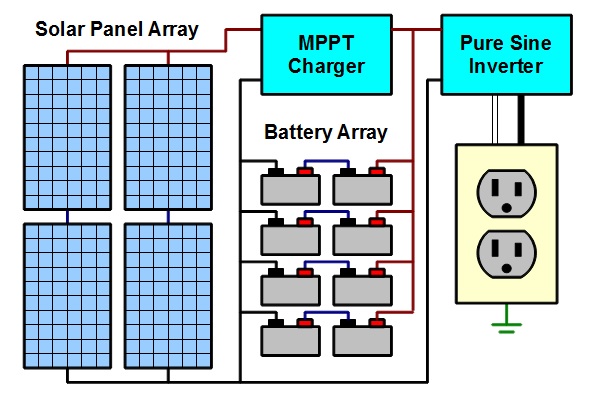
|
|||
|
Solar Panel Arrays
In the previous article in this series, we covered the essentials of selecting a solar charger, and focused on selecting a high-current MPPT charger. Be sure to read that article, or go back to the first article in this series for a complete overview of how to design an off-grid energy system. In this article, we discuss how to create a solar panel array to best feed your charger. Series and Parallel Combinations
At the start of this series, we provided a diagram of a typical off-grid solar installation. This diagram is provided again below: 
The Benefits of Higher Array Voltages
Why connect panels in series at all? There are two main reasons, and both involve the benefits of higher array voltage. The first benefit of a higher array voltage is that the power wires back to the charger can deliver a given amount of power with less current, preventing the need for large and expensive power cables. The second benefit of a higher array voltage involves the operation of the charger itself. In general, whatever battery array voltage you choose, and we already know that a higher battery array voltage is better, most reasonably-priced chargers will not begin charging the batteries until the solar panel array reaches a certain minimum voltage. So, with a higher array voltage, the panels will begin charging on the solar tails earlier and longer than they would with a single panel. And, in some cases, a single panel will not be able to charge a high voltage battery array at all, even at peak solar illumination. The Maximum Array Voltage
Now that we know that the array functions best at higher voltages, what is the maximum voltage we should use, or in other words, how many panels should we use in series in each string? This answer is simple. First, find the open-circuit voltage of the panel you intend to use. This is the absolute maximum voltage the panel can produce under the best of circumstances. Then, find the maximum input voltage for the charger. The maximum number of panels in each string should then be the number of panels whose total open-circuit voltage does not exceed the maximum input voltage of the charger. Derating Your Panels
As we read in the solar panel selection article, each panel is characterized by the manufacturer using a number of parameters, some of which account for nominal rather than maximum performance. When sizing your array, be sure to derate your panels to 72 percent of the maximum output label power. This will not only provide a more realistic estimate of available charging power, but will also help us adjust the size of the array. The Minimum Number of Panels Per String
Sometimes, we might not wish to use the maximum number of panels per string as calculated above. Perhaps the open-circuit voltage is too close to the maximum charger input voltage, or the physical layout is such that wiring four panels in series would be difficult, but three would be simple. Or, a grid of one shape might require more panels than a differently shaped grid. Regardless of why we might want to choose fewer panels per string, the design principle is then to use the derated NOCT voltage (typically 80 percent of the maximum power voltage), and make sure that the number of panels in each string exceeds the battery array charging voltage. This number of panels represents the minimum number of panels per string. Feel free to choose any number panels between these minimum and maximum values, but lean toward the highest number of panels allowed by your charger input voltage. Our Solar Array Calculator
To help with all the necessary calculations, we have created this handy Solar Array Calculator to help with the math and let you focus on design decisions. Now that we understand the issues involved with designing an array of solar panels, and how to make an informed buying decision for these, it is time to discuss using all that energy that we're collecting and storing. This is the topic of our next article: Inverter Selection ... |
Announcements
Amateur Radio Solutions Available Our development staff now includes Amateur Extra radio FCC licensees, increasing the breadth of our existing wireless development services. Posted: 12 Nov 2015 Details Here |
© 2001 - 2016 SoftBaugh, Inc. All rights reserved.